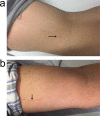rt-PA with remote ischemic postconditioning for acute ischemic stroke
- PMID: 30847368
- PMCID: PMC6389851
- DOI: 10.1002/acn3.713
rt-PA with remote ischemic postconditioning for acute ischemic stroke
Abstract
Objective: To investigate the feasibility and safety of remote ischemic postconditioning (RIPC) in acute ischemic stroke patients after intravenous recombinant tissue plasminogen activator (rt-PA) thrombolysis (IVT).
Methods: We performed a pilot randomized trial involving acute ischemic stroke patients with IVT. The patients were randomized 1:1 to receive RIPC or standard medical therapy. In the RIPC group, the participants underwent instant RIPC within 2 h of IVT, followed by repeated RIPC therapy for 7 days. The feasibility end point was the completion of RIPC and time from the first RIPC to finishing IVT in the RIPC group. The safety end point included tissue and neurovascular injury resulting from RIPC, changes in vital signs, level of plasma myoglobin, any hemorrhagic transformation, and other adverse events.
Results: Thirty patients (15 RIPC and 15 Control) were recruited after IVT. The mean age was 65.7 ± 10.2 years, with a National Institutes of Health Stroke Scale (NIHSS) score of 6.5 (4.0-10.0). The completion rate for RIPC was 97.0%. The mean time from first RIPC to completing IVT was 66.0 (25.0-75.0) min in the RIPC group. One case of hemorrhagic transformation was observed in the RIPC group. No significant difference was found in the level of myoglobin between the two groups (P > 0.05).
Interpretation: RIPC is effective and safe for AIS patients after intravenous rt-PA thrombolysis.
Conflict of interest statement
Dr. Xunming Ji is one of the inventors of the electric autocontrol device that has been patented in China (ZL201420846209.5, China). The other authors declare that they have no conflict of interest.
Figures



Similar articles
-
Safety and efficacy of remote ischemic postconditioning after thrombolysis in patients with stroke.Neurology. 2020 Dec 15;95(24):e3355-e3363. doi: 10.1212/WNL.0000000000010884. Epub 2020 Oct 7. Neurology. 2020. PMID: 33028663 Clinical Trial.
-
Brain Protection Effects of Mild Hypothermia Combined with Distant Ischemic Postconditioning and Thrombolysis in Patients with Acute Ischemic Stroke.Ther Hypothermia Temp Manag. 2024 Sep;14(3):172-178. doi: 10.1089/ther.2023.0043. Epub 2023 Sep 4. Ther Hypothermia Temp Manag. 2024. PMID: 37668993 Clinical Trial.
-
[Signifiance of brush sign on susceptibility-weighted imaging predicts hemorrhagic transformation after intravenous thrombolysis in patients with acute ischemic stroke].Zhejiang Da Xue Xue Bao Yi Xue Ban. 2015 Nov;44(6):625-31. doi: 10.3785/j.issn.1008-9292.2015.11.05. Zhejiang Da Xue Xue Bao Yi Xue Ban. 2015. PMID: 26822044 Free PMC article. Chinese.
-
Is intravenous thrombolysis still necessary in patients who undergo mechanical thrombectomy?Curr Opin Neurol. 2019 Feb;32(1):3-12. doi: 10.1097/WCO.0000000000000633. Curr Opin Neurol. 2019. PMID: 30461464 Review.
-
[Intravenous thrombolysis in ischemic stroke: Therapeutic perspectives].Rev Neurol (Paris). 2015 Dec;171(12):866-75. doi: 10.1016/j.neurol.2015.09.002. Epub 2015 Nov 10. Rev Neurol (Paris). 2015. PMID: 26563662 Review. French.
Cited by
-
Effect of remote ischaemic preconditioning on walking in people with multiple sclerosis: double-blind randomised controlled trial.BMJ Neurol Open. 2020 Mar 23;2(1):e000022. doi: 10.1136/bmjno-2019-000022. eCollection 2020. BMJ Neurol Open. 2020. PMID: 33681776 Free PMC article.
-
Remote Ischemic Conditioning in Ischemic Stroke and Myocardial Infarction: Similarities and Differences.Front Neurol. 2021 Oct 26;12:716316. doi: 10.3389/fneur.2021.716316. eCollection 2021. Front Neurol. 2021. PMID: 34764925 Free PMC article. Review.
-
Remote ischemic conditioning combined with intravenous thrombolysis for acute ischemic stroke.Ann Clin Transl Neurol. 2020 Jun;7(6):972-979. doi: 10.1002/acn3.51063. Epub 2020 May 29. Ann Clin Transl Neurol. 2020. PMID: 32472628 Free PMC article. Clinical Trial.
-
Cerebral protection by remote ischemic post-conditioning in patients with ischemic stroke: A systematic review and meta-analysis of randomized controlled trials.Front Neurol. 2022 Sep 21;13:905400. doi: 10.3389/fneur.2022.905400. eCollection 2022. Front Neurol. 2022. PMID: 36212669 Free PMC article.
-
Effects of Remote Ischemic Conditioning on Cerebral Hemodynamics in Ischemic Stroke.Neuropsychiatr Dis Treat. 2020 Jan 23;16:283-299. doi: 10.2147/NDT.S231944. eCollection 2020. Neuropsychiatr Dis Treat. 2020. PMID: 32021218 Free PMC article. Review.
References
-
- Anderson CS, Robinson T, Lindley RI, et al. Low‐dose versus standard‐dose intravenous alteplase in acute ischemic stroke. N En J Med 2016;374:2313–2323. - PubMed
-
- Hacke W, Kaste M, Bluhmki E, et al. Thrombolysis with alteplase 3 to 4.5 hours after acute ischemic stroke. N En J Med 2008; 359:1317–1329. - PubMed
-
- The National Institute of Neurological Disorders and Stroke rt‐PA Stroke Study Group . Tissue plasminogen activator for acute ischemic stroke. N En J Med 1995;333:1581–1587. - PubMed
-
- Benarroch EE. Tissue plasminogen activator: beyond thrombolysis. Neurology 2007;69:799–802. - PubMed
Publication types
MeSH terms
Substances
LinkOut - more resources
Full Text Sources
Medical

